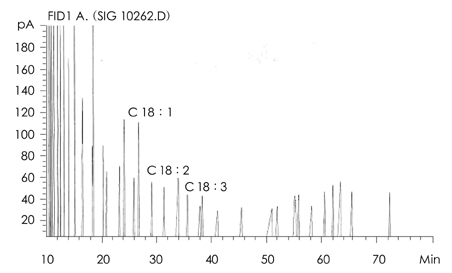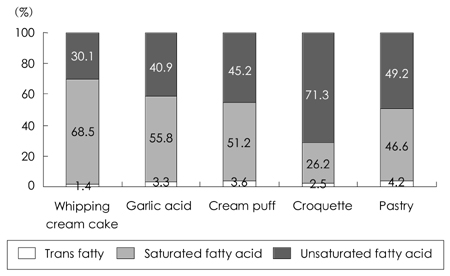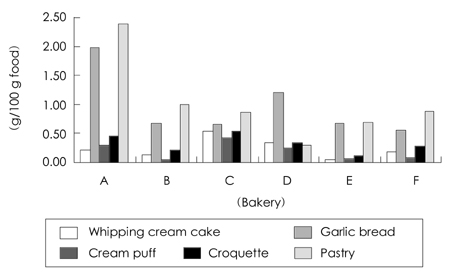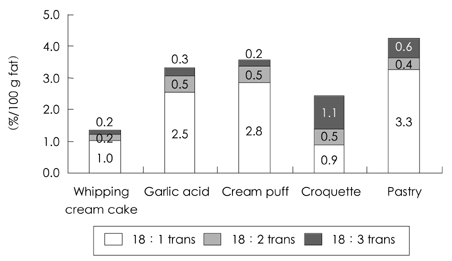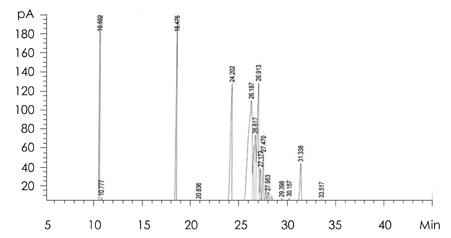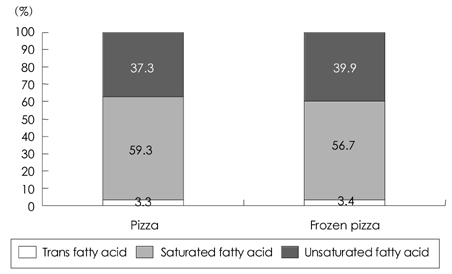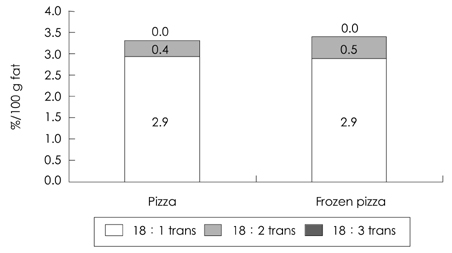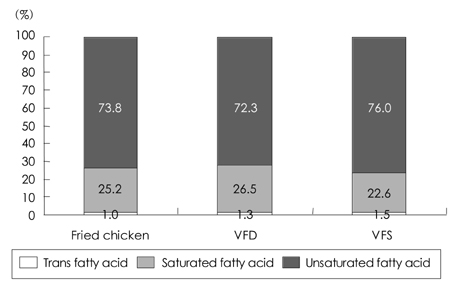Korean J Nutr.
2009 Apr;42(3):291-299. 10.4163/kjn.2009.42.3.291.
Trans Fatty Acid Content in Commercial Processed Food in Jeon-Buk Area
- Affiliations
-
- 1Jeollabukdo Institute of Health & Environmental Research, Jeonju, Korea. jullie57@hanmail.net
- KMID: 2264728
- DOI: http://doi.org/10.4163/kjn.2009.42.3.291
Abstract
- This study was carried out to examine the proportion of fatty acids and contents of trans fatty acid in commercial processed foods in Jeon-Buk area. Contents of trans fatty acid in bakery products ranged from 0.2% to 1.0% per 100 g food. Especially garlic bread and pastry contained the highest amount. Popcorns contained trans fatty acid from 0.0% to 13.4%. Among them, instant popcorns for microwave contained the highest amount, while trans fatty acid was hardly detected in popcorns for theater. And trans fatty acid detected in popcorns was mostly in the form of 18 : 1 trans. The content of trans fatty acid in pizza was nearly 0.2%. Amounts of saturated fatty acid and unsaturated fatty acid were similar between each type of pizza and frozen pizza. Fritters such as fried chickens and vegetables contained trans fatty acid less than 0.2% per 100 g food.
Keyword
Figure
Reference
-
1. Wilkening V. Proposed changes in USA regulations food labeling. J Food Compos Anal. 2001. 14:309.2. Quantitative Analysis of Total fat and Trans Fatty Acid with Heat Treatment and Time Variation of Vegetable Oil and Fats. 2007. KIHE.3. The Annual Report of KFDA. 2004. 8-1:545–551.4. Bethesda MD. Position paper on trans fatty acids. Am J Clin Nutr. 1996. 63:663–670.5. Ascherio AS, Willet C. Health effects of trans fatty acids. Am J Clin Nutr. 1997. 66(s):1006s–1010s.
Article6. Shapiro S. Do trans fatty acids increase the risk of coronary artery disease? A critique of the epidemiologic evidence. Am J Clin Nutr. 1997. 66(s):1011S–1017S.
Article7. Lichtenstein AH. Trans fatty acids and cardiovascular disease risk. Curr Opin Lipidol. 2000. 11:37–42.
Article8. Vijver LP, Kardinaal AF, Couet C, Aro A, Kafatos A, Seingrimdottir L, Amorim CJ, Moreiras O, Becker W, Amelsvoort JM, Vidal Jessel S, Salminen I, Moschandreas J, Sigfusson N, Martin I, Carbajal A, Ytterfors A, Poppel G. Association between trans fatty acid intake and cardiovascular risk factors in Europe: the TRANIR study. Eur J Clin Nutr. 2000. 54:126–135.
Article9. Singha RB, Niaza MA, Ghosha S, Beegoma R, Rastogia V, Sharma JP, Dubeb GK. Association of trans fatty acids (vegetable ghee) and clarified butter (Indian ghee) intake with higher risk of coronary artery disease in rural and urban populations with low fat consumption. Int J Cardiol. 1996. 56:289–298.
Article10. Calson SE, Clandinin MT, Cood HW, Emken EA, Filer LT. Trans fatty acids infant and fetal development. Am J Clin Nutr. 1997. 66:717s–736s.11. Houwelingen ACV, Hornstra G. Trans fatty acids in early human development, in fatty acids and lipid, Biological aspects. World Rev Nutr Diet. 1994. 175–178.12. Kolezko B. Trans fatty acids may impair biosynthesis of long-chain polyunsaturated and growth in man. Acta Paediatr. 1992. 81:302–306.13. Hopkins GJ, Weat CE. Possible roles of dietary fats in carcinogenesis. Life Sci. 1976. 19:1103.14. Mensink RP, Zock PL, Katan MB, Jirnstra G. Effect of dietary cis and trans fatty acids on serum lipoproteins levels in humans. J Lipid Res. 1992. 33:1493.
Article15. Zock PL, Katan MB. Hydrogenation alternatives effects of trans fatty acids and stearic acid versus linoleic acid on serum lipids and lipoproteins in humans. J Lipid Res. 1992. 33:399.
Article16. Korea Food and Drug Admistration, Food Code. 2005.17. Korea Food and Drug Admistration Notification NO. 2007-10. 2007.18. Noh KH, Won MS, Song YS. Trans fatty acid isomers of Processed foods commonly Consumed in korea. J Korean Soc Food Sci Nutr. 2003. 32(3):325–337.
Article19. The Annual Report of KFDA. 2005. 9.20. Wolff RL. Trans-polyunsaturated fatty acids in French edible rapeseed and soybean oils. J Am Oil Chem Soc. 1994. 69:106.
Article21. De Greyt WF, Kellens MJ, Huyghebaert AD. Effect of physical refining on selected minor components in vegetable oils. Lipid/Fett. 1999. 101:428–432.
Article22. Noh KH, Lee KY, Moon JW, Lee MO, Song YS. Trans fatty acid content of Processed foods in korea diet. J Korean Soc Food Sci Nutr. 1999. 28(6):1191–1200.23. Henninger M, Ulberth F. Trans fatty acid content of convenience food. Z. Erährungswiss. 1997. 36:161–168.
- Full Text Links
- Actions
-
Cited
- CITED
-
- Close
- Share
- Similar articles
-
- Fatty Acid Content in Perilla Cultivars and Commercial Oils Determined by GC Analysis
- Perception on Nutrition Labeling of the Processed Food among Elementary School Teachers in Busan
- Nutritional Labeling Practices for Processed Foods According to Food Category
- School Dietitians' Perception on Nutrition Labelling of the Processed and Packaged Foods in Incheon
- Recipe Standardization and Nutrient Analysis of Local Foods of Cheollabuk-do Province(The Second Report)

